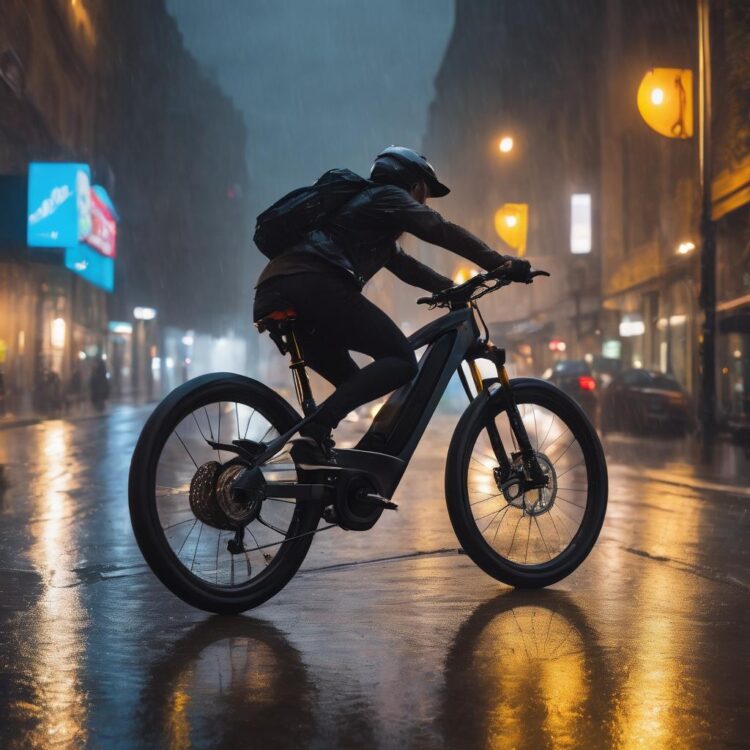Can You Ride an Electric Bike in the Rain?
Electric bikes, or e-bikes, have grown in popularity over the years, proving to be a convenient mode of transportation for many. A common concern among e-bike enthusiasts and potential buyers is the viability of using them in wet conditions. In this article, we will delve into the matter and answer the question: Can you ride an electric bike in the rain?

To address the core question, it’s important to first understand the primary components of an e-bike. These components include the motor, battery, display, and the controller. Most modern e-bikes are designed with weather-resistant features. That said, there’s a difference between weather-resistant and waterproof.
Riding in the Rain: The Short Answer
Yes, you can ride an electric bike in the rain. The electronics in e-bikes are typically sealed against the elements and are often designed to handle mild to moderate rain. However, just like regular bikes, there are precautions you should take.
Precautions When Riding in Wet Conditions
- Check Manufacturer Specifications: Always refer to the user manual or manufacturer’s guidelines. Some e-bikes are designed to be more water-resistant than others.
- Avoid Puddles: While it’s tempting to ride through puddles, doing so could cause water to splash into sensitive areas. Deep water can also pose a risk of submerging parts of the bike, which could lead to damage.
- Regular Maintenance: Rainwater, especially in areas with salty air, can lead to corrosion. Regularly cleaning and drying your e-bike after wet rides can prolong the life of its components.
- Tire Traction: Just as with any other bike, wet conditions can affect tire grip. Be cautious of slippery surfaces and reduce your speed.
- Battery Care: Ensure that the battery compartment is properly sealed. While most e-bike batteries are designed to be water-resistant, repeated exposure to rain can weaken the seals. If possible, remove and store the battery indoors if expecting heavy rainfall.
- Dry Before Charging: Before charging your e-bike, make sure it’s completely dry. Connecting a wet e-bike to electricity can cause short circuits and damage.
Extended Tips
If your a e bike lover, here are some necessary tips for you:
1. Invest in Fenders: Fenders are a game-changer when it comes to wet rides. They prevent water and mud from being flung onto the rider and the e-bike’s motor and battery, protecting both you and the bike’s crucial components.
2. Waterproofing Accessories: Consider using waterproof bags or panniers if you need to carry items. Waterproof covers for your e-bike’s display and battery can also provide an additional layer of protection during heavy downpours.
3. Brake Early: Wet conditions can affect the efficiency of your brakes, especially if they’re rim brakes. Anticipate stops and start braking earlier than usual. Also, try to brake evenly, using both the front and rear brakes to prevent skidding.
4. Use Waterproof Clothing: Investing in a good quality waterproof jacket and pants can make your rainy ride more comfortable. Waterproof shoe covers and gloves can also be beneficial in keeping you warm and dry.
5. Mind the Puddles: As previously mentioned, puddles can be deceptive. They can hide potholes or other obstacles that can cause accidents or damage to your e-bike.
6. Store Properly After Riding: If you’ve ridden through the rain, ensure you store your e-bike in a dry place. If possible, use a dry cloth to wipe down the frame and other components. Avoid storing your e-bike in damp or humid areas as this can cause corrosion over time.
What About Waterproof Ratings?
When considering an e-bike, or any electronic for that matter, you might come across IP ratings – this stands for “Ingress Protection.” An IP rating typically has two numbers; the first one indicates protection against solids (like dust) and the second one against liquids (like water). For example, an IP65-rated e-bike would be dust-tight and protected against water jets from any direction.
It’s beneficial to know the IP rating of your e-bike’s components, especially if you plan on riding frequently in wet conditions. The higher the numbers, the better the protection.
Dealing with E-Bike Battery Concerns in Rain
1. Monitor Battery Health: Wet conditions can sometimes lead to faster battery discharge. It’s essential to regularly monitor your e-bike’s battery health. Over time, if you notice a faster-than-normal discharge during rainy conditions, it might indicate that water has compromised some internal components.
2. Avoid Complete Drain: It’s generally advised for e-bike users not to drain their batteries completely, especially after a rainy ride. Maintaining a charge of about 20% can help prolong the battery’s lifespan and overall health.
Rain’s Impact on E-Bike Performance
1. Rain Impact on Range: Rain and colder temperatures can increase the resistance because of the thicker air and water creating more drag on the tires. This means the motor has to work harder, reducing the bike’s overall range.
2. Lubricate After Wet Rides: Just like a regular bicycle, it’s crucial to lubricate your e-bike’s chain and moving parts after wet rides. Water, especially rainwater, can wash away essential lubricants, leading to increased wear and tear.
Prepping E-Bike for Wet Seasons
1. Seasonal Checkups: If you live in an area where certain seasons are wetter than others, consider having your e-bike inspected and serviced as the season approaches. This can help identify potential issues before they become significant problems.
2. Tires with Wet Grip: Just as cars have rain tires, some bicycle tires are designed to offer better grip in wet conditions. If you often find yourself riding in the rain, it might be worth investing in these types of tires.
3. Mudguards are Essential: While fenders prevent water from splashing upwards, mudguards, especially those that extend closer to the ground at the back, can prevent the water thrown out by the rear wheel from hitting riders or others behind you.
Potential Risks
While it’s generally safe to ride e-bikes in the rain, there are potential risks:
- Electrical Malfunction: Extended exposure to water can lead to electrical failures if water manages to seep into sealed areas.
- Decreased Visibility: Rain can affect visibility, both for the rider and other road users. It’s essential to use lights and wear reflective clothing.
- Reduced Battery Efficiency: Cold and wet conditions can slightly decrease battery efficiency, leading to reduced range.
Final Thoughts
While e-bikes are designed to handle the rain, it’s always best to err on the side of caution. Regular maintenance and following manufacturer’s guidelines can help ensure your e-bike remains in top condition, even when used in wet conditions. Remember, safety first: adjust your riding habits in the rain, be visible, and enjoy the ride!
